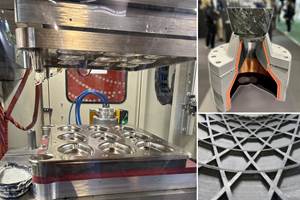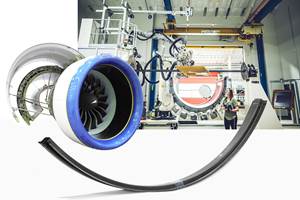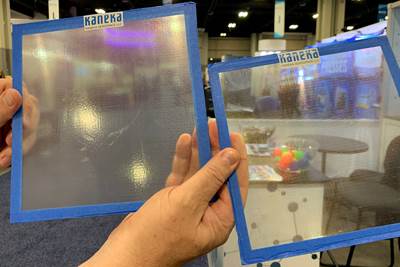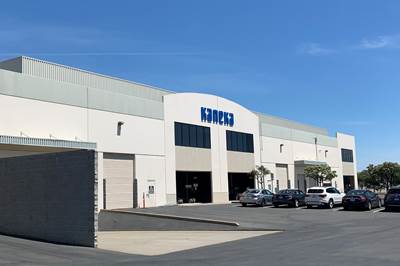Specialty thermoset resins designed for carbon-carbon composites
CAMX 2024: Kaneka Aerospace is demonstrating its novel diamine-based bis-benzoxazine resins, with features such as high char yield, for use as CFRP thermal protection.
Share
Shown here are cured resin films and CFRP after pyrolysis up to 1000°C: (a) Resin film 1, (b) resin film 2 and (c) CFRP. Source | Kaneka North America LLC
Kaneka Aerospace (Benecia, Calif., U.S.) manufactures specialty high-performance prepregs, resins and adhesives for the aerospace and industrial markets. Some of the offerings being presented include Kaneka’s novel diamine-based bis-benzoxazine resins with aldehyde end-terminated groups. Matrix options for high-temperature carbon fiber-reinforced plastics (CFRPs), the resins’ thermal and mechanical properties feature:
- Melt flowability at temperatures below 150°C for processing and converting of uncured resins into fully cross-linked structures by hot press molding at 220°C.
- Cured resins exhibit a high Tg temperature formally well over 230°C with little drop in storage modulus.
- Optimal elongation at break (>4%).
- Weight retention of around 70% for the cured resin when heated in an inert atmosphere to temperatures up to 1000°C
- Resins pyrolyzed up to 1800°C also showed improved residual weight.
Kaneka has also successfully fabricated carbon fiber prepregs with these resins, which were subsequently stacked and cured to yield CFRPs. A presentation in the CAMX theater, titled “Aldehyde Groups Terminated Bis-Benzoxazine Resins With High Char Yield for Carbon-Carbon Composite Applications,” presented by Hideki Yamamoto, highlights some of the preliminary studies on the processing of prepregs using the benzoxazine-based prepregs. Further, details of the post-curing pyrolysis and thermal treatment of the CFRPs are being presented, including a preliminary analysis of the pyrolyzed structure. Notably, the high weight retention of the reported cured resin is said to have translated well even at the CFRP level, which demonstrates optimal weight as well as dimensional retention. These results provide glimpses of the potential of these new materials toward their applications in carbon-carbon composites for the purposes of thermal protection.
Related Content
-
JEC World 2024 highlights: Thermoplastic composites, CMC and novel processes
CW senior technical editor Ginger Gardiner discusses some of the developments and demonstrators shown at the industry’s largest composites exhibition and conference.
-
Welding is not bonding
Discussion of the issues in our understanding of thermoplastic composite welded structures and certification of the latest materials and welding technologies for future airframes.
-
The potential for thermoplastic composite nacelles
Collins Aerospace draws on global team, decades of experience to demonstrate large, curved AFP and welded structures for the next generation of aircraft.
Related Content
JEC World 2024 highlights: Thermoplastic composites, CMC and novel processes
CW senior technical editor Ginger Gardiner discusses some of the developments and demonstrators shown at the industry’s largest composites exhibition and conference.
Read MoreWelding is not bonding
Discussion of the issues in our understanding of thermoplastic composite welded structures and certification of the latest materials and welding technologies for future airframes.
Read MoreThe potential for thermoplastic composite nacelles
Collins Aerospace draws on global team, decades of experience to demonstrate large, curved AFP and welded structures for the next generation of aircraft.
Read MorePlant tour: Airbus, Illescas, Spain
Airbus’ Illescas facility, featuring highly automated composites processes for the A350 lower wing cover and one-piece Section 19 fuselage barrels, works toward production ramp-ups and next-generation aircraft.
Read MoreRead Next
AGY, Kaneka develop transparent fiber-reinforced composite
The S-2 Glass fiber/epoxy material offers tunable transparency, low haze, good impact and mechanical properties.
Read MoreKaneka Aerospace starts up carbon and glass fiber prepreg operations
Subsidiary installs new automated filming and prepreg equipment at Benecia, California, facility, with capabilities to produce 50-inch-wide prepreg tapes ranging from 140-1,100 gsm areal weight.
Read MoreAssembling the Multifunctional Fuselage Demonstrator: The final welds
Building the all-thermoplastic composite fuselage demonstrator comes to an end with continuous ultrasonic welding of the RH longitudinal fuselage joint and resistance welding for coupling of the fuselage frames across the upper and lower halves.
Read More







